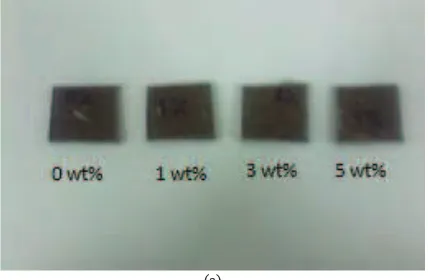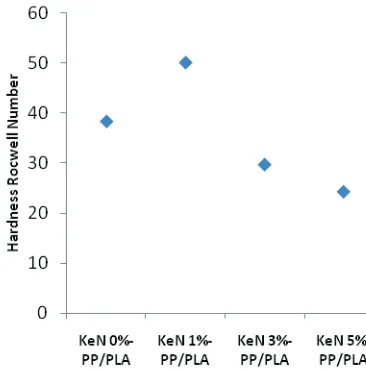3rd International Conference on Engineering and ICT (ICEI2012)
TENSILE AND HARDNESS PROPERTIES OF KENAF-PP/PLA COMPOSITE
FILLED NANOCLAY
M.N.Azmi1a, S.A.Rafeq1b, R.Nadlene1c, M.A.M.Irwan1d and A.M.Aishah1e 1
Universiti Teknikal Malaysia Melaka, Melaka, Malaysia. Email: [email protected], [email protected],
c
[email protected], [email protected], [email protected]
Abstract ! Different amount of nanoclay will be added to the binder of Kenaf fiber composite material in order to investigate the effect of nanoclay loading in the conventional polymer based composite material. The samples were prepared by using the internal mixing technique with constant composition of PP and PLA as the matrix constituent and 40wt% of kenaf fiber. Then, the nanoclay was added into the mixture with different amount, 1wt%, 3 wt% and 5 wt% respectively. Tensile test, hardness test and liquid immersion test were carried out for each sample. Result for tensile test shows increasing of nanoclay loading in the composite cause the decreasing tensile properties. However, 1wt% of nanoclay amount in the composite increases the Young Modulus about 15%. This is supported by the hardness test and liquid immersion test results where the sample with 1wt% of nanoclay shows better result compared to the other specimens.
Keywordsükenaf bast fiber; nanoclay; bio-composites
I. INTRODUCTION
The advanced composite materials based on bast fibers and thermoplastic matrices have received great scientific
attention especially in the area of lightweight,
environmentally friendly, cost-effective composite
materials, further special interest has been concentrated on kenaf fibers as potential reinforcing fillers for many thermoplastic composites [1]. Bast fibers is a anually renewable crop, growing 90 to 100 day. The bast plants are characterized by long, strong fiber bundles that comprise the outer portion of the stalk whereas the core resembles balsa woods. The word bast refers to the outer portion of the stem of these plants. This stringy, vascular portion comprises 10 - 40% of the mass of the stem depending upon the species of bast plant, as well as the particular variety, or cultivar, within a bast plant. The element of the stem inside this bast layer is a different type of fibrous material, which has different names depending on the species selected [2]. In recent years, the growing of environmental awareness and government regulation has created an interest of combining natural fibers with biodegradable polymers/bio-polymers such as poly (lactic acid), poly(3-hydroxybutyrate), poly(caprolactone) and poly(butylene succinate). The combination of the natural fiber and biodegradable polymer is also known as bio-composites [3].
Poly Lactic acid (PLA) is one of biodegradable polymer that undegoes photodegradation, oxidation and hydrolysis proceses [3]. The environmental advantages of PLA is that
it acquire low energy to be produced, other than reduce the green house gas production [4]. For being the most promising bio-based resins that is commercially available, an enormous of attention is given to the potential applications of PLA as a replacement for petroleum based polymers. PLA is made entirely of corn and definitely is compostable. In order to produce the lactic acid, dextrose is processed from the corn starch before being fermented. Then, the lactic acid will be polymerized to produce the PLA. The good thing about the PLA is that at the end of it!s life, it can be composted and degraded to produce energy, carbon dioxide and water [5].
On the other hands, Polypropylene (PP) is a thermoplastic polymer that offers outstanding physical, chemical, mechanical, thermal and electrical properties that does not easily found in any other thermoplastic polymer. As a comparison to low or high density polyethylene, it has a lower impact strength, but superior working temperature and tensile strength. In addition, polypropylene has tremendous resistance to organic solvents, degreasing agents and electrolytic attack. It is also light in weight, resistant to staining, and has low moisture absorption. Moreover, it is suggested for vacuum systems where higher heats and pressures are encountered [6].
An enormous amount of interest is focused in the field of clay-polymer nanocomposite technology. The essential nanoclay raw material is montmorillonite, a 2-to-1 layered smectite clay mineral with a platey structure. Individual platelet thicknesses are just one nanometer (one-billionth of a meter), but surface dimensions are generally 300 to more than 600 nanometers, resulting in an unusually high
aspect ratio. Naturally occurring montmorillonite
is hydrophilic. Since polymers are generally organophilic, unmodified nanoclay disperses in polymers with great difficulty. Therefore through clay surface modification, montmorillonite can be made organophilic and, therefore,
compatible with conventional organic polymers.
3rd International Conference on Engineering and ICT (ICEI2012) nanoclay reinforced polyurethane and 1% nanoclay reinforced polyurethane. The damage analysis showed that the foams with nanoclay had smaller damage are compare to the neat polyurethane [9]. Therefore, by using nanoclay in the sandwich construction structure will not only sustain higher load, reduce the damage size during impact but will also lower the reduction in mechanical properties. It is known that the fiber breakage in the composite is due to the low stiffness properties of the matrix. The nanoclay-filled polymers help in enhancing the localized crack tip strength by hold up the bond even if the fiber is breakage, therefore the objective of this study is investigate the effect of nanoclay loading in matrix of the kenaf fiber composites properties towards the improvement of tensile properties of conventional kenaf fiber composite.
II. MATERIALS & SAMPLE PREPARATION
In this study, PP was mixed with an emulsion-type of PLA in order to produce the polymer matrix. The matrix is reinforced by kenaf bast fiber and small amount of modified montmorillonite, or known as nanoclay. The kenaf bast fiber are already harvested, retted, dried, and mechanically separated. The nanoclay is the nanomer I.28E nanoclay that is designed for easy dispersion and enhanced at low loading. composition of PP and PLA was prepared as shown in table 1. From the tensile test, PP/PLA 3% shows the optimum value of PP/PLA mixture. Thus, in this study, the ratio for PP and PLA will be recognized as 3:97 respectively. Whereas the other 4 specimens for composite materials was fabricated without nanoclay (Neat) and with nanoclay
loading • 1wt%, 3wt% and 5wt% - as shown in table 2. In
this study there are 3 testing that been considered to achieved the objectives - tensile test, hardness test and porosity test.
Table 1. Composition for PP/PLA
Specimens PLA (%) PP (%)
PP/PLA 0% 0 100
PP/PLA 3% 3 97
PP/PLA 5% 5 95
PP/PLA 10% 10 90
Table 2. Composition of 1, 3, 5 wt% of nanoclay loading KeN-PP/PLA specimen
Tensile test was carried out according to ASTM D 3039/D 3039M, using Universal Testing Machine (UTM) in order to investigate the modulus of elasticity, elastic limit, elongation, proportional limit, reduction in area, tensile strength, yield point, yield strength and other tensile properties of the specimen. The test was done at crosshead speed 2mm/min with a load of 10kN.
B. Hardness Test
The hardness test was done using Rockwell hardness test based on UNI 4271 ASTM D785/60T plastic standard. The indenter ball diameter is 5mm and the test is made on five spots of the specimen.
C. Porosity Test
Liquid Immersion Test was conducted to investigate the porosity of the fabricated specimen. The specimen size is 2.5cm x 2.5cm. The weight of the specimens is measured then it is left to be immersed in kerosene for 24 hours. After that the specimen was dried and subsequently weighted. Figure 1 shows the specimen and the immersion test conducted.
3rd International Conference on Engineering and ICT (ICEI2012) Specimens being immersed in the kerosene
III. RESULT & DISCUSSION
Figure 2 shows the average tensile strength and Young Modulus of the composite samples containing 40wt% Kenaf fiber prepared with different nanoclay amount. The Young!s Modulus of the specimen increased about 15% at 1wt% of nanoclay loading and decreased at larger amount of nanoclay loading. Meanwhile, tensile strength of the specimens shows an inclination pattern with the increasing of the nanoclay amount. The decrement of the tensile strength as the nanoclay loading increased is probably due to the high number of agglomerate. The high number of agglomerates creates pores that effect the force distribution between the fibers in the composite. The liquid immersion test proved that the porosity index is higher when higher number of nanoclay amount is added into the polymer matrix as shown in Figure 3. Consequently, the composite material turns out to be non-homogenous since the porosity index is high and thus decreasing the force distribution within the composite.
Figure 4 shows the Hardness test result which indicates that the hardness of the composite improved at 1wt% of nanoclay amount. However, the hardness of the sample decreases when nanoclay amount is larger than 1wt%.
Figure 2. Percentage of Nanoclay amount to the Young Modulus and Tensile Strength for each specimen.
Figure 3. Percentage of weight increment after the liquid immersion test
Figure 5. Average of Hardess Rockwell Number.
IV. CONCLUSION
3rd International Conference on Engineering and ICT (ICEI2012)
Melaka, Malaysia 4 • 5 April 2012
✪ ✫
ACKNOWLEDGEMENT
The author would like to thank the Faculty of Manufacturing, UTeM for giving the opportunity to conduct the experiments. The author would also like to thanks to Mr. Jeefferie bin Abd Razak for the technical support.
REFERENCES
[1] Srebrenkoska, V., Dimeski, D., Bogoeva-Gaceva, G., Grozdanov, A., Buzarovska, A. (2006). "Characterization of Kenaf/PLA Composites#.University Sts. Cyril and Methodius [2] Lloyd, E. H., Seber, D. (2007). "Bast Fiber Applications For
Composites#.
[3] Ramarad, S. (2008). "Preparation and Properties of Kenaf Bast Fiber Filled (Plasticized) Poly (Lactic Acid) Composites#. Thesis Master of Science.
[4] Henton, D. E., Gruber, P., Lunt, J., Randall, J.(2005). "Poly Lactic Acid Technology#. Page 528-569
[5] Harris, A. M., Lee, E. C.(2006). "Injection Molded PLA composites for Automotive Application#. Ford Motor Company. Materials Research and Advanced Engineering. [6] San Diago Plastic. Inc, site
http://www.sdplastics.com/polypro.html (retrieved on 2th October 2010)
[7] Briell, B. (2006). "Nanoclays • Counting on Consistency#. Southern Clay Product Inc. : Senior Scientist.
[8] Hosur, M. V., Mohammed, A. A., Zainuddin, S., and Jeelani, S. (2006). "Processing of nanoclay filled sandwich composites and their response to low-velocity impact loading#. pp. 101-116.

